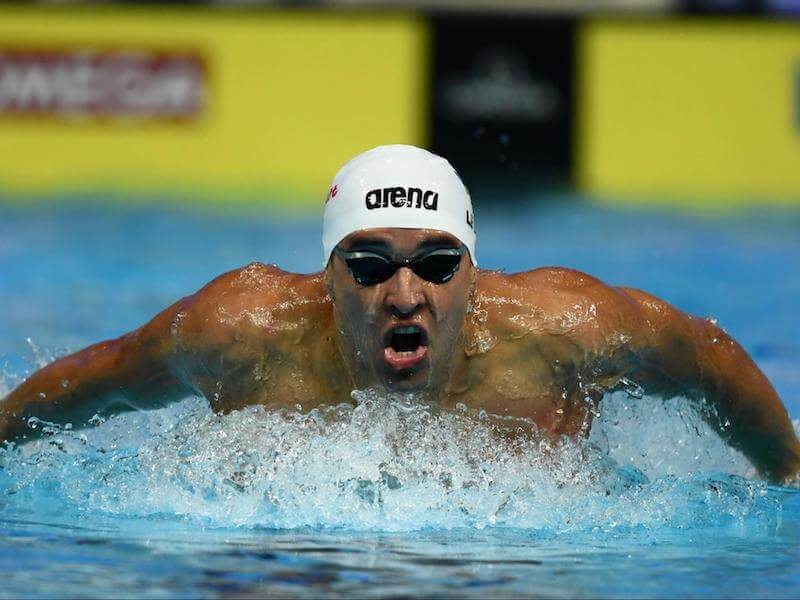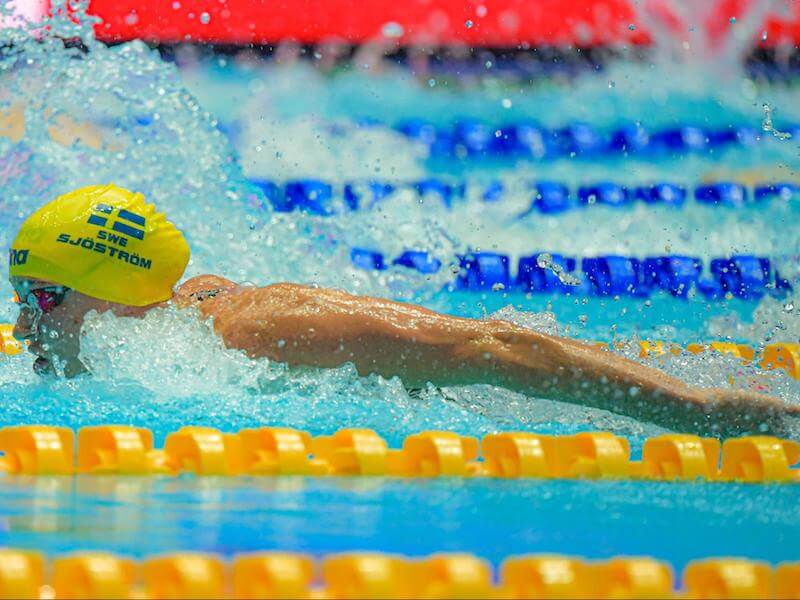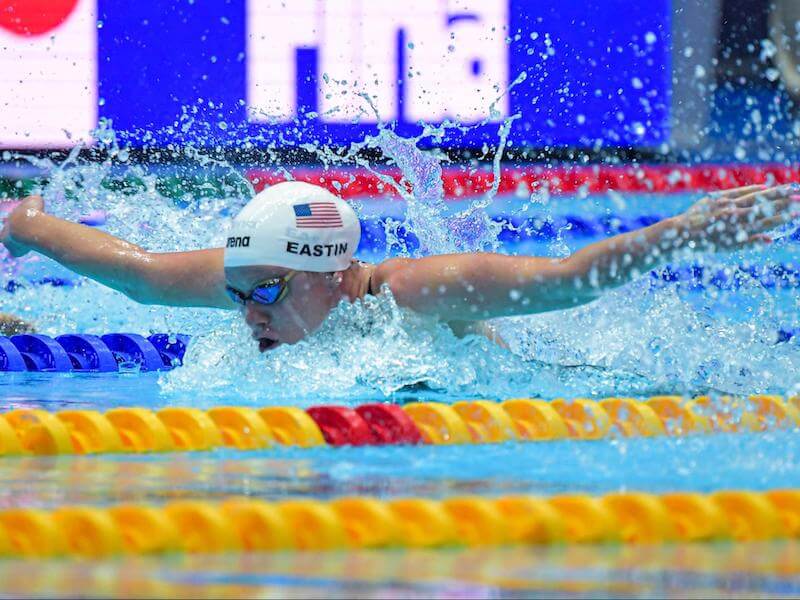Improve Your Form With These 12 Butterfly Drills
The butterfly stroke is iconic in the swimming world. It is challenging to learn and difficult to master, but the physical and mental rewards of improving in this stroke are well worth it. You’ll feel your body become stronger and more in sync with each day you practice the butterfly stroke.
Whether you’re a beginner recreational swimmer just learning how to swim butterfly or a competitive swimming athlete pursuing an Olympic dream, taking the time to master proper butterfly form is a must if you want to improve your stroke. This article will provide a few tips and drills to help you achieve excellent butterfly form.
Tips for Improved Butterfly Form
Of all the swimming strokes, butterfly is one of the most challenging. The butterfly stroke burns more calories during one hour of swimming than any other stroke. A butterfly swimmer who weighs 155 pounds (70 kg) will burn 774 calories in an hour. That is 70 more calories than the same person would burn when swimming freestyle or breaststroke.
Not only does the stroke expend a lot of energy, but the form of the stroke itself can be hard to perfect. Taking the time to train with proper butterfly technique will help you achieve efficiency in your stroke, allowing you to maximize the energy you expend while swimming. The following tips will help to improve critical areas of your stroke technique.
Body Position
As with any swim stroke, how you position your body in the water plays a significant role in efficiency and speed. As you swim butterfly, you want to make sure your body is aligned. When you align yourself properly, each part of your body can participate in the whole movement.
When swimming butterfly, you will be undulating as you move through the water. Undulation allows you to move through the water more efficiently. The purpose of this type of body motion is to propel yourself forward. It is similar to the body motion used during an underwater dolphin kick and allows your upper body and legs to alternate in propelling you across the pool.
Keep your head position neutral. Don’t look up too much, as this can slow you down. Do your best to stay near the surface of the water so you can reduce the amount of drag you experience as you swim.
Butterfly Arms
As you take butterfly strokes, focus on proper arm movement and how your hands enter the water. Extend your arms with your elbows slightly bent and keep your hands somewhat further apart than the width of your shoulders when they enter the water.
Once your hands enter the water, pull as if performing a freestyle stroke but using both hands simultaneously. Focus on pulling equally with both arms, using your forearms and hands to catch as much water as possible. Pull straight down at first and allow your hands to come slightly closer together as you continue to pull toward your hips.
In the arm recovery phase of the stroke, your hands should leave the water by your hips and stay close to the surface. Do not lift your arms too high out of the pool, which wastes energy.
Butterfly Kick
In the butterfly stroke, kicking provides a large amount of propulsion. The butterfly kick is similar in form to the dolphin kick. Both legs will perform a large, powerful kicking motion simultaneously. Your legs must remain together, and keep your feet pointed behind you.
For every stroke cycle you complete with your arms, you will kick twice. The first kick you take provides enough forward propulsion so you can lift your arms out of the water during the recovery phase of your stroke cycle. The second kick occurs before you begin your pull and provides additional drive to keep your forward momentum up.
Breathing

The number-one mistake you want to avoid when breathing is lifting your head too high out of the water. When you lift your head, your hips will drop, and you’ll sink into the water, slowing you down. Your head should come out of the water just enough for you to take a breath and then should drop back into a neutral position.
Swimming butterfly is tiring, so you might need to breathe every stroke if you are new to it. As your form and cardiovascular endurance improve, you might find you can take a breath less frequently than every stroke cycle. Breathing every other or every third stroke allows you to keep your head down longer so you can cut down on drag.
12 Butterfly Drills to Practice Your Skills

Now that you have a basic understanding of how to swim butterfly with proper form, you can practice some of the swimming drills below to improve your skills. Remember to stay positive through your training, even if these butterfly stroke drills seem challenging. As long as you continue to train, you’ll see improvement.
1. By the Side of the Pool
Mimic and visualize the mechanics of the butterfly stroke outside of the water by the side of the pool. Lay on your stomach and bend your knees slightly to imitate the leg kick as your hands come forward and enter the imaginary water in front of you. Perform another kick when your arms reach your sides. This drill will help you visualize the mechanics of the stroke before you enter the water.
2. With Short Fins
There are a lot of opportunities for training with swim fins, and these tools make an excellent option for butterfly drills. Swim the butterfly with short swim fins, taking one arm stroke for every 3-4 leg kicks. Focus on the form of your leg kick during this drill. The added resistance provided by the fins will allow more sensory response to the movement of your legs through the stroke.
3. Butterfly Kick Drill
For this drill, you will need a kickboard. Grab the kickboard firmly and practice your butterfly kicking technique. If you can, allow the kickboard to dive under the water in front of you and then come back to the surface as you complete your kicking cycle. This will help you to master the undulating motion involved in the stroke.
4. Butterfly With Pull Buoy
Place a pull buoy between your legs and swim butterfly using only your arms. This drill will improve your arm strength and help you focus on proper upper-body mechanics. Try to pull equally with both your right arm and left arm during each stroke you take.
5. One-Arm Butterfly
Swim the butterfly using just one arm without moving the other. Keep the arm that is not in use extended out in front of you or along your side. It is extremely important to breathe forward and not laterally when performing this drill.
6. Breaststroke Legs With Lateral Breathing
Swim the butterfly using a breaststroke leg kick every arm stroke, breathing once to the right and once to the left, attempting to keep your head underwater as much as possible.
7. Butterfly With a Flutter Kick
Swim the butterfly using a freestyle leg kick. Try to keep your shoulders above the water when performing this drill. Focus on your arm mechanics. Practice a powerful pull-through and efficient recovery phase.
8. Variable Entry
As you swim, your first stroke should have a wide hand entry. In your second stroke, your hand should enter the water at half the width of your previous stroke. For your third stroke, your hands should enter the water next to one another in front of your head. Your fourth stroke will return to the original wide entry. Repeat this variable entry cycle throughout the drill.
9. Underwater Recovery
Swim the butterfly without the recovery part of the arm stroke. Make sure your arms are below your chest and try to go as deep as possible with your shoulders by thrusting your back powerfully downward.
10. Clenched Fists
Swim the butterfly with clenched fists to keep your arms and legs as coordinated as possible.
11. One Leg Kick
Swim the butterfly making just one leg kick for every complete arm cycle, inserting it at the end of the pull phase right before beginning the recovery phase above the water.
12. Full Stroke for Time
Once you feel more comfortable swimming the complete stroke with proper form, try timing yourself swimming 50 meters, 100 meters, and 200 meters at a time. Keeping a log of your times is a great way to track improvement throughout practicing your butterfly drills!
Practice Your Butterfly Drills and See the Results

The key to improving any swimming technique is to keep up with consistent practice. Take your time to think about proper mechanics before you enter the water and while you are swimming. Continue implementing some of the butterfly drills listed above every time you train and your stroke will continue to improve.
Are you looking for the ideal training swimsuit for your own specific needs? Be sure to look at these training suits for men and women!
Written by:
arena coaches
Swim coaches, trainers and experts will give you all kinds of tips for performing at your best in both training and races.







